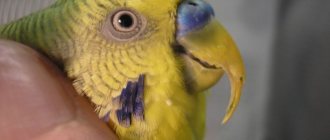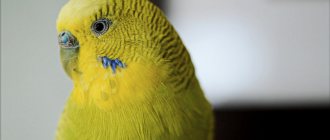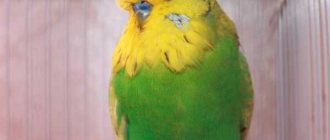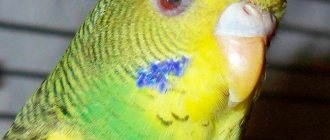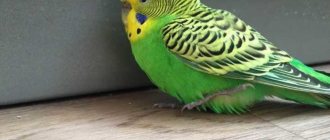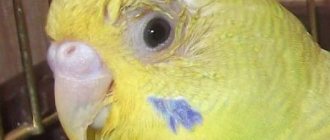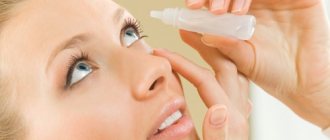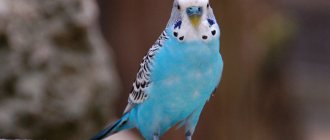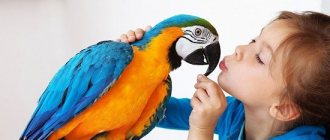Colds in parrots are quite common. A caring owner should know the causes, symptoms and treatment methods for his pet in advance. Timely assistance will help avoid serious illnesses.
The manifestation of a runny nose in a parrot indicates both a cold and the development of respiratory diseases. In some cases, secretory discharge from the nostrils may indicate a parasitic infection. In the process of making a diagnosis, it is very important to correctly determine the bird’s disease, using not only visually appearing symptoms, but also laboratory tests.
Symptoms
The disease is accompanied by a runny nose, so it is easy to notice mucous fluid around the nose.
The feathers near the nostrils become dirty and stick together. The secreted liquid mixes with food particles and dries, forming hard crusts that interfere with normal breathing.
The parrot, in an attempt to free its nasal openings, rubs its beak against the cage, sneezes, and breathes with its mouth open. He is depressed, refuses food, and sits with a ruffled face.
If an additional symptom appears - inflammation of the conjunctiva, we can conclude that psittacosis is developing.
Such a pet must be urgently isolated and examined for the presence of chlamydia.
Risk factors
Usually parrots catch a cold due to violation of the conditions of detention. We are talking about temperature conditions. The pet will inevitably get sick if the room where its cage is located is colder than +17-18 degrees. Drafts are also contraindicated for him. Remember this when ventilating the room.
Too cool water in a drinking bowl or bathtub can harm your parrot. Monitor its temperature, do not allow it to be below room temperature.
The parrot runs the risk of hypothermia when transported in the cold season. A heat-loving pet should travel in a heated carrier, inside a car or in the owner’s bosom.
Treatment
Psittacosis is dangerous not only for parrots, but also for humans, so first of all, the veterinarian administers an antibiotic to suppress the pathogen.
It is also recommended to take a smear to determine the sensitivity of the pathogen to tetracycline.
The taken biomaterial is studied in the laboratory, and the result allows you to select the most effective drug if tetracycline does not bring results.
Also, to strengthen the pet’s immunity, medications are prescribed - paraimmunity stimulants, multivitamin injections.
Powdered vitamin C has a good effect; it is added to drinking water.
The area near the nasal passages is carefully cleaned of crusts and secretions with a cotton pad dipped in warm water.
Inflamed skin is treated with ointment with vitamin A or fish oil.
Since birds are constantly cold, they need warmth. To do this, the cell is irradiated with a 60 W light bulb.
At the same time, the pet should have the opportunity to move to another perch if it gets hot. The lamp should work continuously until complete recovery.
A steam bath with chamomile has proven effective in liquefying thick secretions. Chamomile decoction is poured into a saucepan and placed in front of the cage.
Cover the front with a scarf so that warm steam enters the cage. It is enough to carry out the procedure 1-2 times a day.
Equipment, toys, drinking bowls and feeders require regular treatment - washing with hot water and brushing.
This will destroy the pathogen and prevent re-infection.
The natural habitat of parrots is regions with high air humidity, so staying in dry, heated rooms leads to drying out of the mucous membranes of the respiratory tract and a decrease in their resistance to infections.
To prevent this situation, it is recommended to install an air humidifier.
If this is not possible, place a damp towel on the battery and change or wet it regularly.
The bird should be bathed daily, and if bathing is not carried out, spray it with warm water or douse it several times a day.
Is there a threat to the parrot's life?
The metabolism in the body of birds is very intense, which is why the disease has a rapid course. Even a slight delay in treatment will result in fatal consequences not only for the health, but also for the life of the pet.
Read also
Life expectancy of budgerigars at home Agree, this question does not immediately come to mind after the decision is made to get a budgerigar. Really,…
A runny nose in a budgie, even in the absence of other symptoms, requires urgent contact with an ornithologist. Deterioration of a pet's condition without treatment can lead to its death in a matter of hours.
Possible complications
If left untreated, the bird suffers from difficulty breathing. Infection of the lungs and other internal organs is also possible.
The owners and other birds living in the house are at risk, so the sick individual must be isolated for a while.
Call a veterinarian to your home 24 hours a day
Ornithologists from our veterinary clinic make house calls around the clock in Moscow and the Moscow region.
This service allows you to:
- spend a few hours on other purposes, rather than on long trips to the veterinary center and back,
- take advantage of affordable prices and convenient payment methods,
- ask all your questions regarding keeping and caring for pets,
- Get a doctor's consultation on all pets living with you.
Call and arrange a convenient day for a professional to come. And if the situation is urgent, an ambulance team is offered, arriving at the scene within 20-40 minutes.
General services
| Prices for services in our clinic | In the clinic and at home |
| Ornithologist visiting your home | from 500 |
| Clinical examination, preliminary diagnosis, consultation | from 500 |
| Telephone consultation | for free |
| Therapy | from 150 |
| Surgery | from 150 |
| Ambulance at home (within an hour) | from 1000 |
Therapy
| Prices for services in our clinic | In the clinic and at home |
| Subcutaneous administration of medication to birds | from 200 |
| Intramuscular administration of medication to birds | from 150 |
| Intravenous administration of the drug to birds | from 500 |
| Bird dropper | from 1000 |
| Administration of the drug intraperitoneally, intraosseously | from 800 |
| Nerve receptor blockade in birds | from 500 |
| Tube feeding of birds | from 300 |
| Cleaning the horny cover | from 400 |
| Resuscitation treatment of birds | from 1500 |
| Infusion therapy | from 250 |
| Intravenous catheter placement | 500 |
| Removing the IV catheter | 500 |
| Removing the Marking Ring | from 200-1000 |
| Taking blood for laboratory tests | from 350 |
| Obstetrics in birds | 1 hour from 500 |
| Washing the crop | from 500 |
| Trimming: | |
| Beak | 500 |
| Claws | 500 |
| Krylyev | 500-1000 |
| Tail | 500-1000 |
Surgery and Traumatology
| Prices for services in our clinic | In the clinic and at home |
| Surgical treatment of wounds | from 200-1000 |
| Stitching | from 300-1500 |
| Application of a splint | from 300 |
| Opening abscesses, hematomas | from 300 |
| Removal of tumors | from 1000 |
| Goiter surgery | from 1500 |
| Cloaca surgery | from 1500 |
| Removal of foreign bodies | from 1500 |
| Eye amputation | from 2000 |
| Pelvic limb amputation | from 2500 |
| Osteosynthesis | from 10000-30000 |
| Surgery for goiter rupture | from 1500 |
| Egg extraction | from 500 |
| Anesthesia for birds | from 1500-3500 |
| Puncture of air sacs | from 1000 |
| Abdominal wall puncture | from 1000 |
Anesthesiology for birds
| Prices for services in our clinic | In the clinic and at home |
| Anesthesia | from 500 |
Ophthalmology
| Prices for services in our clinic | In the clinic and at home |
| Eyelid surgery for inversion, eversion | from 2000 |
| Exenteration of the eyeball | from 3000 |
Laboratory research
| Prices for services in our clinic | In the clinic and at home |
| Taking tests | 500 |
| Clinical blood test | 1000 |
| General clinical blood test | 1000 |
| Blood chemistry | 2000 |
| Microscopy of blood parasites | 700 |
| Smear microscopy | 700 |
| Examination of droppings for protozoa | 1000 |
| Examination of droppings for helminths | 700 |
| Determination of gender | 2000 |
| Histological examination | 2500 |
| Examination of droppings for helminths | 700 |
| Infectious anemia of chickens | 1500 |
| Test for infectious encephalomyelitis | 1500 |
| Analysis for infectious bronchitis of birds | 1500 |
| Analysis for infectious rhinotracheitis in birds | 1500 |
| Salmonellosis test | 1500 |
| Testing for trichomoniasis | 1500 |
| Tuberculosis test | 1500 |
| Examination of droppings for protozoa | 1000 |
| Analysis for psittacosis | 1500 |
| Analysis for pasteurellosis | 1500 |
| Avian influenza test | 1500 |
| Analysis for dysbacteriosis | 2000 |
| Analysis for avian mycoplasmosis | 1500 |
| Newcastle disease test | 1500 |
| Analysis for avian leukemia | 1500 |
| Test for Marek's disease | 1500 |
| Analysis for avian adenovirus | 1500 |
| Analysis for avian circovirus | 2000 |
| Analysis for yeast-like fungi | 1700 |
| Comprehensive analysis for anthropozoonoses | 4000 |
| General bacteriological analysis | 3000 |
| Gumboro disease | 1500 |
| Avian reovirus | 1500 |
Laryngotracheitis
The disease most often manifests itself in summer and autumn. Refers to infectious. In most cases, laryngotracheitis affects large species of parrots. Signs of the disease include:
- Labored breathing;
- Sneezing;
- Cough;
- Rhinitis with mucous discharge from the nostrils.
The disease is diagnosed and a course of treatment is established in a specialized clinic. As a preventive measure, an antibacterial course is prescribed. To exclude mass disease, vaccination of adults is carried out.
How to treat cough with wheezing?
What to do when you have a cough with wheezing, as mentioned above, depends on the disease that caused this symptom. After a comprehensive examination and diagnosis, the doctor may prescribe several drugs from different drug groups.
Antibiotics
.
Prescribed for diseases caused by pathogenic bacteria. Antibacterial drugs inhibit the vital activity of these microorganisms and cause their death, but should be selected only by a doctor and solely taking into account the sensitivity of microbes to certain drugs. Antihistamines
.
This group of medications is prescribed for cough and other respiratory, skin, or gastrointestinal symptoms caused by allergies. Also, antihistamines can be part of a complex of drugs prescribed for acute respiratory viral infections. Bronchodilators
.
This group of drugs is recommended for coughs with wheezing, which are caused by a narrowing of the lumen of the bronchi. They help normalize breathing, eliminate shortness of breath, and restore the function of removing mucus from the bronchi. This group of drugs has different mechanisms of action, so the specific drug should be selected by the attending physician based on the characteristics of the situation. Mucolytic
.
These agents thin the mucus and prevent it from settling on the walls of the bronchi. This facilitates the removal of both mucus itself and pathogenic microorganisms and toxic products of their vital activity. Doctor MOM® syrup and herbal cough lozenges have pronounced mucolytic and bronchodilator effects, which are based on the action of a complex of medicinal plants. Antipyretics
. They can be recommended for elevated body temperature. An integrated approach to the treatment of cough with wheezing of any origin is important, since it is only one of the symptoms of the disease.
COVID-19 in children from 6 to 12 years old
Symptoms of Covid in children aged 6 to 12 years are similar to the typical clinical picture of ARVI - sore throat, nasal congestion, cough. A rise in temperature from 37 to 38 degrees occurs more often in them than in younger children. Added to the clinical picture are symptoms in children aged 9 to 12 years, such as aching muscles and joints, conjunctivitis, a purple-red rash, loss of appetite, myalgia (muscle pain) and headache. The course of the disease in children of this age group is more reminiscent of the symptoms of coronavirus in adults. COVID-19 in adolescents
In children over 12 years of age, the classic clinical picture of coronavirus infection is more common. They may develop an intense dry cough, sore throat, runny nose, loss of smell and taste, and distorted perception of odors. Unlike patients in younger age groups, adolescents may experience malaise with headache and muscle pain. COVID-19 is especially dangerous for those teenagers who have previously been diagnosed with heart disease. Under the influence of the virus, the myocardium is damaged, which leads to serious consequences related to the functioning of the heart.
Even if the main symptoms are not observed, it is better to consult a pediatrician , who will prescribe an additional examination and establish the correct diagnosis.
You can call a pediatrician at the Euromed Kids clinic at home by calling +7 812 331 00 00
Coronavirus in newborns (0 to 4 weeks) children
To date, there has been no evidence of intrauterine infection caused by mother-to-child transmission. All cases of coronavirus infection are considered acquired after the birth of the baby. As the incidence rate increases, the number of newborns infected by mothers with coronavirus infection has increased. Worldwide, only 5% of all recorded cases of COVID-19 occur in children under one year of age. Most often, infants experience an asymptomatic or mild course of the disease, which may be accompanied by a slight rise in body temperature.
Medical practice describes such symptoms of coronavirus in children in the first weeks of life as “groaning” breathing, increased work of the respiratory muscles, apnea, cough and tachycardia. Sometimes weak sucking, lethargy, regurgitation, diarrhea, and bloating are observed. Cases of covid pneumonia are extremely rare. Most often, a severe form of coronavirus occurs in children with congenital malformations. The risk of complications increases in the case of: prematurity, birth injuries, pulmonary dysplasia and tumors.
Reasons for the development of pharyngitis
Experts believe that the peak development of pathology occurs at the end of winter and the beginning of spring, since at this time the human immune system is especially susceptible to colds. Often in the spring season, a lack of vitamins and microelements in the human body leads to the appearance of vitamin deficiency, the body weakens and creates an excellent environment for the development of pathogenic bacteria. Inflammatory processes are also possible: both separately and against the background of the underlying disease.
The first signs of pharyngitis and its further treatment may differ depending on the stage of the pathology, gender, age and general health of the patient.
We include the following as the main reasons for the development of pharyngolaryngitis:
- hypothermia, eating too cold foods;
- deformation of the nasal septum;
- strains of microorganisms that cause the development of chlamydia, candidiasis, whooping cough, scarlet fever, measles;
- adenovirus, influenza virus;
- streptococci, staphylococci, pneumococci;
- sinusitis, tonsillitis, caries, rhinitis;
- difficulty breathing through the nose;
- pathologies of the gastrointestinal tract: reflux, heartburn, hernia;
- abuse of bad habits;
- regular high loads on the vocal cords;
- polluted, toxic air;
- hormonal disorders and endocrine pathologies (diabetes mellitus, obesity, hypothyroidism, etc.);
- tonsillectomy, which was performed on the patient previously;
- infectious diseases in chronic form;
- weakened immunity.
Diagnosis of coronavirus in children
When the first signs characteristic of COVID-19 appear and/or when a child comes into contact with a person with confirmed coronavirus, you must call a pediatrician . He will examine the child, prescribe a PCR smear for coronavirus and a general blood test. Based on the test result, the pediatrician will give recommendations for caring for the child, prescribe treatment, and, if necessary, refer for consultation to other specialists (pulmonologist, otolaryngologist, ophthalmologist, etc.). If pneumonia is suspected, an X-ray or computed tomography scan of the lungs is performed.
To detect respiratory failure, you can use a pulse oximeter, a device that helps measure the concentration of oxygen in arterial blood. Pulse oximeter readings should not be lower than 96 units.

